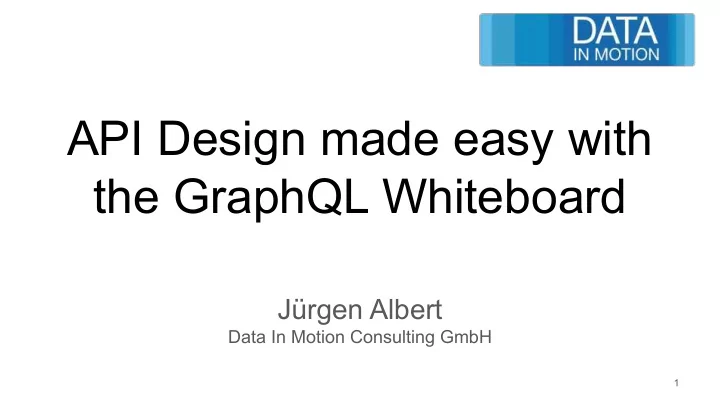

API Design made easy with the GraphQL Whiteboard Jürgen Albert Data In Motion Consulting GmbH 1
About Us ● Founded in 2010 ● Located in Jena/Thuringia - Germany ● Consulting, Independen RnD, Development, Training ● Assisted Development on complex and distributed systems ● Wide Range of Industries like, Medical, Transportation, Traffic, Public Sector, Smart City and Industrial IoT 2
What is GraphQL - History ● Developed by Facebook ● Since 2012, the base for the Facebook mobile App ● Open Source since 2015 ● Resides under the GraphQL Foundation since end of 2018/beginning of 2019 as part of the Linux Foundation ● Biggest Members ○ AWS ○ Facebook ○ IBM ○ Twitter ○ PayPal ○ shopify 3
What is GraphQL ● A Query Language and Runtime for an API ● Alternative to REST, especially if your API needs to provide for a wide range of use cases ● Best suited Backend to Frontend APIs 4
What is a Use Case Consider An API for the following Model 5
The Eclipse Start Process REST API? ● GET /address ● GET /address/{id} ● GET /address/{id}/person ● GET /address/{id}/person/{id} ● GET /person ● GET /person/{id} ● GET /person/{id}/relativs ? ● GET /person/{id}/relativs/{id} ? ● A Lot of possible use cases, depending ● How many hirachy levels do you want to return e.g. with the address? 6
GraphQL to the rescue ● GraphQL defines a simple schema for the API ○ Entities ■ Fields ■ Data types ■ Validation ○ Operations (Fields with Arguments) ■ Mutations (Data manipulation) ■ Querys ○ Subscriptions 7
How would it look like? ● Define a Schema, either in Code or with one of the available Schema DSL. type Address { type AddressService { id: ID! getAddresses(id: String): [Address]! street: String } number: String zipcode: String city: String residents: [Person]! } type Person { id: ID! name: String! relatives: [Person]! address: [Address]! } 8
How would it look like? ● Attache data fetchers to every junktion in your Schema public class RelativesFetcherImpl implements DataFetcher<List<Person>> { /* * (non-Javadoc) * @see graphql.schema.DataFetcher#get(graphql.schema.DataFetchingEnvironment) */ @Override public List<Person> get(DataFetchingEnvironment environment) throws Exception { Person p = environment.getSource(); return p.getRelatives(); } } 9
How would it look like? ● Gives you quite a lot of freedom public class GetAddressesFetcherImpl implements DataFetcher<List<Address>> { @Reference AddressQuery addressService; /* * (non-Javadoc) * @see graphql.schema.DataFetcher#get(graphql.schema.DataFetchingEnvironment) */ @Override public List<Address> get(DataFetchingEnvironment environment) throws Exception { String idArgument = environment.getArgument("id"); return addressService.getAddresses(idArgument); } } 10
What is the GraphQL White board? ● In OSGi we have Services, that provide Java Classes that execute logic (Datafetchers) ● The Java Classes are the Model that describes the Schema we are working with. “It was so nice, lets do it twice!” - I don’t think so 11
What is the GraphQL White board? Lets see! 12
Next Steps ● Remove binding to slf4j ● Update to latest GraphQL Version (currently supports 11) ● Better POJO Support ● Tutorials and Documentation ● Templates ● Get it more stable and easier to use 13
Thanks for listening! Resources: Web: https://www.datainmotion.de Blog: https://datainmotion.de/blog Git: https://gitlab.com/gecko.io/geckographql https://gitlab.com/gecko.io/talks/ece2019_graphql Repos: https://devel.data-in-motion.biz/repository/gecko/snapshot/geckoGraphQL/ https://devel.data-in-motion.biz/nexus/repository/maven-releases/ 14
15
Recommend
More recommend